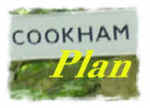
The Cookham Plan
Findings and Recommendations
Housing and Development Group
APPENDIX 3 - ESTIMATE OF SHELTERED HOUSING NEEDS
| MAIN REPORT INDEX | HOUSING AND DEVELOPMENT INDEX |
Appendix 3. Estimate of Sheltered Housing Needs
Introduction
Following the meeting of Working Group leaders on 13 June 2007, the Housing & Development Working Group were requested to provide an estimate of demand for sheltered housing within Cookham.
This has proved difficult to do as a result of the apparent lack of published planning norms for such accommodation. We have, however managed to locate an analysis of existing provision across local authority areas in England and this forms the basis for our estimate.
Source Documents
Statistics on ‘Extra Care’ Sheltered Housing in England (Elderly Accommodation Counsel, April 2005)( 9.1)
Parish Profile - People (National Statistics, 2001 Census)( 9.2)
Existing provision levels
The paper by the Elderly Accommodation Counsel (EAC) defines ‘Extra Care’ Housing as having the following attributes:
-
being housing first - not an institution;
-
enables people to age in place - appropriate design, plus help and encouragement towards independent living;
-
perhaps also providing intermediate care and rehabilitation services.
EAC’s analysis takes a broad view of whether existing facilities meet these criteria. The paper seeks to identify the number of units in each local authority area in England and expresses the provision in terms of units per 1000 people over 65. In summary, the findings are:
Minimum Provision (all areas) 0 (in 92 areas)
Maximum Provision (all areas) 30.8 (Richmondshire)
Average Provision (all areas) 3.4
Minimum Provision (Berkshire) 1.6 (West Berks)
Maximum Provision (Berkshire) 8.4 (Reading)
Average Provision (Berkshire) 5.1
Provision (RBWM) 3.6
For the purposes of this estimate, we have assumed that a reasonable provision level is 6 units per 1000 people over 65. This is based upon the Berkshire average plus a 20% allowance to cover the potential under-measurement which EAC acknowledge may be inherent in their data.
Cookham’s Needs
The 2001 Census shows Cookham having a total population of 5,519 of whom 569 were aged 65 - 74 and 496 were 75 or over (a total of 1,065 over 65). Using the norm of 6 units per 1000, this translates as a requirement of 6 units.
The census also shows that there are 1,558 people aged between 45 and 64. If we make a very simplistic assumption that, by the end of the 20 year period of the plan, the population of over 65s comprises all those currently in the 45 - 74 age range (and this would need adjusting for mortality rates and population shifts in a more accurate estimate), then the population of over 65s will grow to 2,127 requiring 13 units.
As shown in Figure 9.1 on page 96 of the Housing & Development report, Cookham currently has 25 sheltered units. This suggests that supply is more than adequate for local demand.
This finding is in conflict with views expressed in the questionnaire. We cannot conclusively explain this but possible reasons may be:
-
The relatively low overall provision in RBWM puts pressure on the spaces in Cookham from outside the village.
-
The accommodation does not meet local people’s requirements in some way (perhaps a reluctance to use housing association accommodation rather than private sector provision?).
Taking these factors into account, we can see that there may be justification for a small scale private sheltered housing development in Cookham but that this is unlikely to need more that an absolute maximum of 13 units based solely on local needs.